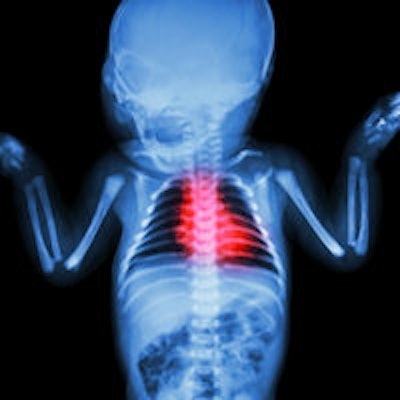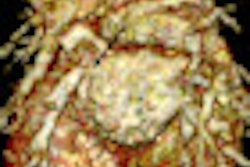
Developing a keen awareness of the radiological features of congenital chest wall deformities is a useful clinical skill, and imaging can also illustrate pre- and postsurgical appearances for more conditions requiring surgical correction, according to award-winning research from a top facility in London.
"There are a variety of congenital conditions affecting the chest wall that commonly presents at birth or childhood," noted Dr. Basrull Najmi Bhaludin, a specialist registrar in radiology at St. George's Healthcare National Health Service (NHS) Trust, and colleagues. "Familiarity with the different congenital chest wall deformities allows accurate diagnosis and provides helpful information for appropriate patient treatment."
In an e-poster that received a Cum Laude award at last month's annual meeting of the European Society of Thoracic Imaging (ESTI), held in Amsterdam, they stated their aim was to identify common chest wall malformations and the pathology; understand common surgical correction procedures; and identify postsurgical appearances. They described the characteristic radiographic and CT appearances of these conditions.
Congenital chest wall deformities are due to anomalies of chest wall growth or prominence, leading to sternal depression, or deformities related to failure of normal spinal or rib development, the authors explained. Cross-sectional imaging allows appreciation of the involved structures; assessment of displacement or deformity of adjacent but otherwise normal structures; differentiation between anatomical deformity and neoplasia; and in some cases CT also is useful for surgical planning.
Pectus excavatum, or funnel chest
Pectus excavatum is the most common congenital deformity of the sternum, and its incidence is about 1 in 400 births. It affects men more than women, and is uncommon among African Americans and Latinos. Most cases are congenital, but around 15% of cases appear later during development and these are frequently associated with abnormalities of connective tissues such as Marfan and Ehlers-Danlos syndrome, they wrote.
Pectus excavatum is characterized by the presence of deep sternal depression, causing the ribs on each side to protrude more anteriorly than the sternum. The sternal and cartilaginous depression causes a reduction in the prevertebral space, leading to a leftward displacement and axial rotation of the heart. Other features include decreased density of the heart, an indistinct right heart border, horizontal posterior ribs, and vertical anterior ribs, and these features can be seen on chest radiographs.
"While pectus excavatum is usually detected clinically, CT may be used to quantify the severity of the deformity especially when surgical intervention is being considered. Severity may be guided using the Haller index, which is based on the ratio of lateral and anteroposterior thoracic diameters," Bhaludin and colleagues noted.
In normal children, the Haller index ranges from 1.9 to 2.7, and an index of greater than 3.25 would require surgical correction. The Haller index for children younger than age 2 is markedly lower than that in older children, and girls up to 6 and between 12 and 18 years old may have a higher index than their male counterparts. Different phases of respiration may affect the Haller index and yield a value significantly lower during inspiration. This reflects advances in CT scanner technology, in comparison to Haller's day, when scans were performed over multiple breath-holds, they added.
Pectus excavatum is easily diagnosed in childhood, but is commonly ignored. Many patients experience detrimental cardiovascular and respiratory physiological changes as they mature, which may be due to decreasing chest wall compliance with increasing age.
The two most common surgical procedures used to correct pectus excavatum deformities are the Nuss procedure and the modified Ravitch procedure. The former is a minimally invasive procedure and consists of implanting two curved retrosternal metallic bars, inserted through small lateral incisions. Chest radiographs can visualize the position of the Nuss and Ravitch bars, and detect any complications, including wound infections, hematomas, bar migration, and pneumothorax, according to the researchers.
Pectus carinatum, or pigeon chest, is the second most common congenital deformity of the sternum, with its incidence estimated to be five times lower than pectus excavatum. It is characterized by an abnormal anterior protrusion of the sternum and costochondral joints. Initial lateral chest radiographs will demonstate sternal protrusion, while CT allows quantification of the severity using the Haller index.
Pectus arcuatum means "wave-like" chest deformity and is a rare condition with an unknown etiology. The term is used to describe mixed deformities containing both excavatum and carinatum, either along a longitudinal or axial axis, and is also known as a pouter pigeon chest. The pouter pigeon chest can be seen on sagittal CT images, but traditionally lateral chest radiography is used, they continued. Imaging with CT allows calculation of the angle of Louis, or sternal angle, to determine the severity of the deformity. The normal angle of Louis is between 145° and 175°, and surgical correction is recommended in patients with an angle of 130° or less.
Poland syndrome is a nongenetic congenital abnormality of unknown etiology. It is characterized by partial or total absence of the pectoral muscles and is most commonly unilateral. There is a range of breast involvement, varying from mild hypoplasia to complete absence (amastia). It is associated with rib cage anomalies in up to 60% of cases, including aplasia or hypoplasia of the ribs, and other associations include hand involvement, lung herniation, and dextrocardia.
Rib osteochondromas can be solitary or associated with multiple hereditary exostoses. Up to 50% of patients with multiple hereditary exostoses may have rib osteochondromas. Exostoses projecting outward can be palpable, whereas internal exostoses may be an incidental finding on imaging only.
"On chest radiography, the affected side appears of increased transradiancy due to reduction in overlying soft tissues. CT is useful to demonstrate the absence of the greater pectoral muscle and any associated musculoskeletal anomalies of the chest wall," the authors stated. "Surgical correction is only required if there is a rib defect large enough to cause a lung herniation or if there are concerns of injury to the heart or lungs. Adolescent females with amastia may also require cosmetic reconstruction."
There are normal asymptomatic variations of the anterior chest wall that may be incidental on imaging, and they may include a tilted sternum, convex anterior ribs, or prominent costal cartilages, the team concluded.



















